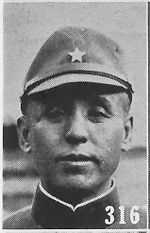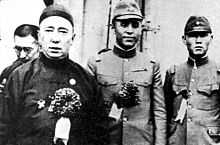Li Shouxin
| Li Shouxin 李守信 | |
|---|---|
 | |
| Commander of Mengjiang National Army | |
| In office 1937–1941 | |
| Personal details | |
| Born | July 11, 1872 Inner Mongolia, Empire of China |
| Died | May 1970, age 98 Hohot, Inner Mongolia, People’s Republic of China |
| Nationality | Mongol |
Li Shouxin (Chinese: 李守信; pinyin: Lǐ Shǒuxìn; Wade-Giles: Li Shou-hsin, Hepburn: Ri Shyushin; July 11, 1892 - May 1970) was a pro-Japanese commander in Mengjiang National Army, and later the Manchukuo Imperial Army.
Biography
Of ethnic Mongol descent, Li was born into a family of minor landlords. In 1919, he enlisted in the military forces of the Zhili clique in Jehol province, rising steadily through the ranks until he reached the position of colonel, with an equivalent ranking being granted by the Kuomingtang government. Assigned to Tongliao in what is now Inner Mongolia, he helped assist in the suppressing the revolt of Gada Meiren in 1929.
In 1933, his forces clashed with the Imperial Japanese Army on the border with Manchukuo, and Li managed to down a Japanese aircraft. However, this opened the door to negotiations, and in exchange for weapons, money and supplies, Li defected to the Japanese side, and was appointed commander of a portion of Inner Mongolia and Jehol. In 1933 commanded the Manchukuo forces defending the fortifications around Duolun against the Chahar People's Anti-Japanese Army. In late 1935 he commanded Manchukuo forces aiding Teh Wang in seizing control of the six northern districts of Chahar. The following two years he was in command of the Manchukuo detachment of the Inner Mongolian Army attempting to capture Suiyuan province. By February 1936, Li controlled a large area in Chahar province, and transferred his allegiance to Prince Demchugdongrub and became Chief of Staff of the new Inner Mongol Army. With the establishment Mengjiang, Li became the commander of the Mengjiang National Army.
In 1940, Li met in Tsingtao with Zhou Fohai and representatives of the Nanjing Nationalist Government with the aim of discussing the integration of Mengjiang into China. This was accomplished in 1941, with Mengjiang becoming the Mongolian Autonomous Federation (蒙古自治邦), albeit with complete autonomy.

Sources
- Dryburgh, Marjor. North China and Japanese Expansion 1933-1937: Regional Power and the National Interest. RoutledgeCurzon (2000). ISBN 0-7007-1274-7
- Jowett, Phillip S., Rays of The Rising Sun, Armed Forces of Japan’s Asian Allies 1931-45, Volume I: China & Manchuria, 2004. Helion & Co. Ltd., England.
- 中国抗日战争正面战场作战记 (China's Anti-Japanese War Combat Operations)
- Guo Rugui, editor-in-chief Huang Yuzhang
- Jiangsu People's Publishing House
- Date published : 2005-7-1
- ISBN 7-214-03034-9
- Online in Chinese: http://www.wehoo.net/book/wlwh/a30012/A0170.htm
- 第二部分:从“九一八”事变到西安事变察哈尔民众抗日同盟军 1
- Part II : from the "September 18 Incident" to the Xi'an Incident: Anti-Japan military alliance
- http://www.wehoo.net/book/wlwh/a30012/04574.htm